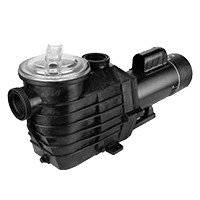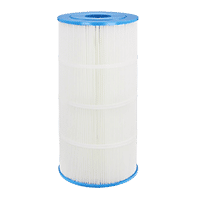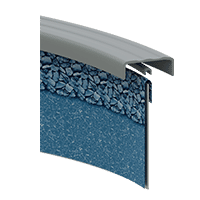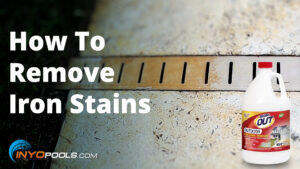In this guide, we break down common H-Series Error Codes for the Universal H-Series Low-NOx pool heater and explain the best ways to troubleshoot them. The Hayward H-Series is known for being one of the most versatile pool heaters on the market, but even the most rugged designs can occasionally display a fault code.
Why Hayward H-Series Low-Nox Is So Popular
The Hayward Universal H-Series LoNOx pool heater is the Swiss Army Knife of pool heaters; its myriad features make it applicable for 90 percent (or more) applications. The H-Series comes standard with a cupro-nickel heat exchanger, allowing it to be installed on traditional liquid or tablet chlorine-sanitized pools as well as salt pools. Hayward’s low emissions (Low-NOx) design makes it compatible with the state of California’s emissions regulations, the strictest in the country; other manufacturers like Raypak require a special order version of their standard heaters to meet those standards. The overlooked feature of a forced air-fed combustion chamber ensures the heater receives enough air for a clean burn for top efficiency. The constant air flow means the Universal H-Series can be installed on pool or spa applications in elevations up to 10,000 feet.
bD – Internal Fault / Gas Valve Error, Data Retrieval Issue
Bad Board or Secondary High Voltage Fault
| Diagnosis Steps | Fault Remedy |
|---|---|
| 1. Verify the FC4 Fuse on the Fuse Board is not open | Remove FC4 from the fuse holder. Measure continuity across fuse. If OK, reinstall the fuse and proceed to step 2. If the Fuse is open, proceed to the section titled ‘‘Open FC4 Fuse’’. |
| 2. Verify high voltage output from Fuse Board | Disconnect the plug from the P6 connector of the Fuse Board. Measure for 120VAC across Pins 3 and 5 of the P6 receptacle on the Fuse Board. If OK, reconnect the plug and proceed to step 3. If not OK, go to step 4. |
| 3. Check for defective Harness | Disconnect the plug from the E10 connector of the control module. Measure for 120VAC across pins 1 and 3 of Plug on Harness. If OK, replace Control Module. If not OK, replace Harness. |
| 4. Check for defective Transformers. | Disconnect the plug from P4 connector of Fuse Board. Measure for 120VAC between pins 4 and 6 of the plug from the Transformer. If OK, proceed to step 5. If not OK, replace the Transformer. |
| 5. The Fuse Board is defective | Replace Fuse Board. |
HF – Flame Present With Gas Valve “OFF” Error
If flame is sensed with the gas valve off the control will go into lockout. The blower will run until error condition is corrected. When corrected, control will run blower for 5 s then automatically restart after 2 minutes.
Flame Present with Gas Valve not Energized
| Diagnosis Steps | Fault Remedy |
|---|---|
| 1. ICB is defective | Using the sight glass, check to see if the flame is present in the unit. If not, replace ICB. If flame is present, move to next step. Without disconnecting the valve from the wiring harness, use a voltmeter to determine if 24 VAC is present at the gas valve connections. If so, replace ICB. If not, move to step 3. |
| 2. Gas Valve is defective | Replace Gas Valve. – Natural Gas Valve for Hayward Universal H-Series Low Nox Pool Heater – FDXLGSV0001; Propane (LP) Gas Valve for Hayward Universal H-Series Low Nox Pool Heater – FDXLGSV0002 |
PF – Electrical Supply Wiring Error
This code will display if 120V polarity is reversed, low voltage is detected, or if the ground path is not sufficient. Reset is immediate after error is corrected.
AO – Blower Vacuum Switch Open
If the blower prover switch does not close after the blower starts the control will stop the ignition trial go into lockout. The blower will continue to run. Automatic reset is immediate after the switch closes
Blower vacuum switch open when expected closed error – If the blower prover switch opens unexpectedly during operation the control will shut down and attempt to re-light. If the switch does not close after the blower starts the control will go into lockout with the blower running. Automatic reset is immediate after error is corrected
Blower vacuum switch open during post-purge error – If the blower prover switch opens during the post-purge cycle (heater is not firing) the control will display the error code. The post-purge cycle will be completed once the blower prover switch closes.
| Diagnosis Steps | Fault Remedy |
|---|---|
| 1. Check for faulty vacuum switch tubing | Check the tubing and replace if necessary. If OK, proceed to step 2. |
| 2. Check for faulty vacuum switch wiring or connection. | Inspect vacuum switch wiring. Ensure wire harness terminals are securely fastened to spade terminals on vacuum switch. If OK, proceed to step 3 |
| 3. Check for faulty blower wiring or connection | Inspect blower wiring. Ensure plug on blower is securely fastened to control module. If OK, proceed to step 4 |
| 4. Check for defective vacuum switch | Disconnect Blower plug from Control Module. Measure resistance across Blower windings. Winding resistance across lead should be in the following range; Red-to-White: 4 to 5 ohms. If measured values vary substantially from these values, Blower is defective. Replace. If OK, proceed to step 5. |
| 5. Check for defective blower relay | Disconnect Blower plug from Control Module. Place heater in Poolor Spa Mode. Lower set point temperature to generate call for heat.During pre-purge period, measure for 120VAC across pins 1 and 2.If 120VAC is not present, control module relay is defective. Replace control module. If OK, proceed to step 6. |
| 6. Vacuum switch is defective | Replace the blower vacuum switch. |
AC – Blower Vacuum Switch Closed When Expected Open Error
If the blower prover switch is closed before blower start-up the control will not start the blower. Automatic reset is immediate when the switch opens.
| Diagnosis Steps | Fault Remedy |
|---|---|
| 1. Check for defective blower on relay or control module. | Disconnect Blower plug fron Control Module. With heater off, measure continuity across pins 1 and 2 of receptacle on Control Module. If closed, control module relay is defective. Replace control module. If OK, proceed to step 2. |
| 2. Vacuum switch is defective. | Replace blower vacuum switch. |
IO – Igniter Open Error
If the control is not in lockout and senses that the igniter circuit is open when the blower is running the control will turn off the blower and go into lockout. Automatic restart 2 min after error is corrected.
| Diagnosis Steps | Fault Remedy |
|---|---|
| 1. Check for faulty wiring or connection. | Inspect Igniter wiring. Ensure Igniter Plug is securely attached to Control Module. If OK, proceed to step 2. |
| 2. Igniter is defective | Replace the Igniter – FDXLIGN1930. |
SF – Thermistor Error
An excessive temperature difference between the two thermistors (5 °F or more) or an “out of bounds” condition on both sensors (less than 10°F or greater than 180°F) will result in the error code. Automatic restart is 2 minutes after the error is corrected.
| Diagnosis Steps | Fault Remedy |
|---|---|
| 1. Check for faulty wiring or connection | Inspect sensor wiring. Ensure sensor is plugged into back of control module. If OK, proceed to step 2 |
| 2. Sensor is defective | Replace the temperature sensor (Thermistor) – FDXLTER1930. |
HS – Water Temperature Sensing Error
A) Inlet water temperature sensor is reporting a temperature in excess of 104°F. Normal operation resumes 2 minutes after inlet water temperature sensor reports temperatures of 104°F or less. This error functions in both normal and remote thermostat modes.
or
B) Inlet water temperature sensor is reporting a temperature change at a rate faster than 6°F in 60 seconds or less while the heater is firing, indicating a potentially damaging low water flow condition. Normal operation resumes when temperatures stabilize. If this condition is detected 3 times in a one hour period, the heater will lock-out until the electrical power is cycled off and back on.
| Diagnosis Steps | Fault Remedy |
|---|---|
| 1. Check remote thermostat setting | Verify set point setting of remote thermostat is at or below 104°F. If set point of remote thermostat is OK, or if heater is not configured for remote thermostat, proceed to step 2. |
| 2. Verify that the water flow is adequate | Verify that the water flow to heater is above minimum required (20 GPM for H150FD and H200FD, 25 GPM for H250FD and H300FD, 30 GPM for H350FD and H400FD). Note that intermittent periods of low water flow will cause this error. If OK, proceed to step 3. |
| 3. Check inlet water temperature sensor | Compare the heater’s temperature reading to the pool water temperature with an accurate thermometer. If significantly different, replace the inlet water temperature sensor (Thermistor) – FDXLTER1930. |
sB – Keypad Button Stuck Closed Error
If one of the keypad buttons is closed (or pressed) for more than 30 s the error code will be displayed but the control will continue to function. The error code will be cleared when the condition is corrected.
Keypad Failure
| Diagnosis Steps | Fault Remedy |
|---|---|
| 1. Keypad is defective | Replace Display Interface Assembly. Hayward Bezel & Keypad Assembly – Used Only on Heaters Made Before 11/20/14, Serial #21131411103613001 or Lower – FDXLBKP1930 Hayward Bezel & Keypad Assembly – Used Only on Heaters Made After 11/20/14, Serial #21131411103613001 and Higher – FDXLBKP1932 |
IF – Ignition Failure Error
If the control exceeds the maximum number of ignition retries or recycles, the heater will shut down and go into lockout. Automatic reset is 60 minutes.
| Diagnosis Steps | Fault Remedy |
|---|---|
| 1. Ensure gas supply shutoff valves are open. | 1. Measure voltage across gas valve during trial for igintion. If 24VAC is present and gas valve does not open, gas valve is defective. Replace gas valve. 2. If 24VAC is not present, gas valve relay on control module is defective. Replace the control module. |
| 2. Check for low gas supply pressure | Ensure inlet gas supply pressure is between the minimum and maximum values indicated on rating plate. If OK, proceed to step 3. |
| 3. Check for faulty flame sense wiring or connection. | Inspect flame sense wiring. Ensure wire harness terminals are securely fastened to flame sense and to control module. If OK, proceed to step 4. |
| 4. Check for faulty gas valve wiring or connection | Inspect gas valve wiring. Ensure wire harness terminals are securely fastened to spade terminals on gas valve. If OK, proceed to step 5. |
| 5. Check for gas valve failure or gas valve relay failure. | 1. Measure voltage across gas valve during trial for igintion. If 24VAC is present and gas valve does not open, gas valve is defective. Replace gas valve. 2. If 24VAC is not present, gas valve relay on control module is defective. Replace control module. |
| 6. Check for blockages in gas orifices and burners | Inspect gas orifices for blockages which could prevent gas flow. Remove and inspect burners for blockages. |
CE – Communication Error
Communication Error between Control Module and Display Interface Assembly
If communication between the ignition board and the display board is not established within 3 s of power-up an error will be displayed. After communication is established, if it is lost for 30 s, the error will be displayed. The error code will be cleared upon a valid data exchange between boards.
| Diagnosis Steps | Fault Remedy |
|---|---|
| 1. Disconnect and then reconnect power to heater. | |
| 2. Check for faulty wiring or connection. | Inspect Display Interface Wiring. Ensure Display Interface Plug is securely attached to Control Module. If OK, proceed to step 2. |
| 3. Control Module and/or Display Interface Assembly are defective. | Replace Control Module and/or Display Interface Assembly. |
LO – Limit String Open Error
If the limit string opens the heater shuts down and goes into lockout. Automatic restart is 2 minutes after the error condition is corrected and the limit string closes. See the troubleshooting section for more detail.
Water Pressure Switch Fault
| Diagnosis Steps | Fault Remedy |
|---|---|
| 1. Verify that the pump is running | This is a normal display when the pump is off. Turn pump on. LO code should clear. If LO does not clear, proceed to step 2. |
| 2. Verify that water flow is adequate | Verify that water flow rate to heater is above minimum required (20 GPM for H150FD and H200FD, 25 GPM for H250FD and H300FD, 30 GPM for H350FD and H400FD). If OK, proceed to step 3 |
| 3. Check for faulty wiring or connection. | Inspect water pressure switch wiring. Ensure wire harness terminals are securely fastened to spade terminals on water pressure switch. If OK, procced to step 4. |
| 4. Verify state of water pressure switch contacts. | Remove wire leads from water pressure switch and measure continuity across water pressure pressure switch with the pump running. If open, proceed to step 5. If closed, LO code is not caused by water pressure switch fault. Reconnect wire leads to water pressure switch. |
| 5. Ensure that low pump pressure does not exist. | Clean filter or clear blockages. Check position of valves in plumbing system. If OK proceed to step 6. |
| 6. Check for correct water pressure switch setting. | Adjust water pressure switch setting as shown on page 35 of Installation Manual (only if heater is above or below water level). If LO does not clear, proceed to step 7 |
| 7. Water pressure switch is defective | Replace water pressure switch. |
Vent Pressure Switch Fault
| Diagnosis Steps | Fault Remedy |
|---|---|
| 1. Check for faulty wiring or connection. | Inspect vent pressure switch wiring. Ensure wire harness terminals are securely fastened to spade terminals on vent pressure switch. If OK, proceed to step 2. |
| 2. Verify state of vent pressure contacts. | Remove wire leads from vent pressure switch and jumper leads. Operate heater. Measure continuity across vent pressure switch. If closed, LO code is not caused by vent pressure switch fault. If open, proceed to step 3. Remove jumper from wire leads and reconnect wire leads to vent pressure switch. |
| 3. Check for restricted or blocked flue. | Ensure that flue is not blocked or restricted. See indoor vent sizing requirements in installation manual. If OK, proceed to step 4. |
| 4. Vent pressure switch is defective. | Replace vent pressure switch. |
Temperature Limit Switch Fault
| Diagnosis Steps | Fault Remedy |
|---|---|
| 1. Check for faulty wiring or connection. | Inspect temperature limit switch wiring. Ensure wire harness teminals are securely fastened to spade terminals on temperature limit switches. If OK, proceed to step 2. |
| 2. Verify state of temperature limits’ contacts | Remove wire leads from limit switch and jumper leads. Operate heater. Measure continity across limit switches. If closed, LO code is not caused by temperature limit switch fault. If open, proceed to step 3. Remove jumper from leads and reconnect leads to temperature limits. |
| 3. Verify that water flow is adequate | Verify that water flow rate to heater is above the minimum required (20 GPM for H150FD and H200FD, 25 GPM for H250FD and H300FD, 30 GPM for H350FD and H400FD). If OK, proceed to step 4. |
| 4. Temperature limit switch is defective. | Replace temperature limit switch. |
Exhaust Gas Temperature Limit Fault
| Diagnosis Steps | Fault Remedy |
|---|---|
| 1. Check for faulty wiring or connection | Inspect temperature limit switch wiring. Ensure wire harness terminals are securely fastened to spade terminals on temperature limit switch located in the flue collector panel above the center of the header. If OK, proceed to step 2. |
| 2. Verify state of temperature limit’s contacts | Remove wire leads from limit switch and measure continuity across limit switch contacts. If closed, LO code is not caused by exhaust gas temperature limit switch fault. If open, proceed to step 3. |
| 3. Heat exchanger has been damaged | Heat exchanger has been damaged. This is generally due to low water flow, poor water chemistry, or a combination of these and other factors. Rectify all issues with water flow through the heater and water chemistry and then replace the heat exchanger and exhaust gas temperature limit. Continuing to run the heater after this limit has tripped will cause damage to the entire unit and will not be covered by the warranty. |
EE – EEPROM ERROR
Bad Board
| Diagnosis Steps | Fault Remedy |
|---|---|
| 1. Defective Control Module | Replace the Control Module |
bO – Bypass Operation
| Diagnosis Steps | Fault Remedy |
|---|---|
| 1. Check to see if Control Module is in Bypass Operation | This is normal display when heater is being controlled by a remote thermostat. No service is required. If heater is not being controlled by remote thermostat, change setting by using the MODE key to put the heater into STANDBY. Press and hold the DOWN key and then press and hold the MODE key. Hold down both keys for 3 seconds until the indication ‘‘bO’’ is removed from the display. |













Leave a Reply